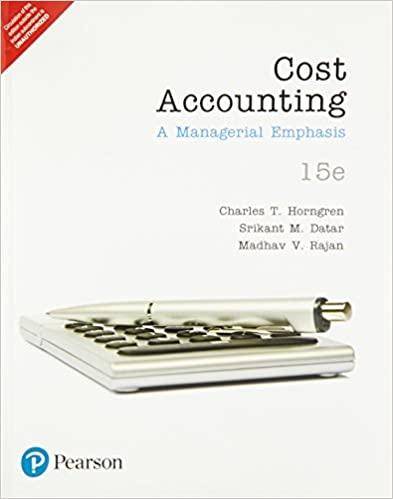1. Compute and interpret the predetermined overhead rate. 2. a. Prepare journal entries to record the january transactions. b. Post the entries to the general ledger T-accounts given earlier in the problem. 3. How much overhead would be applied to jobs during the period? 4. Compute the total cost of jobs 102 and 103 at the end of the period. Where would the cost of each of these jobs appear on the year-end balance sheet? 5. Calculate the amount of over-or underapplied overhead. 6. a. Prepare the journal entry to dispose of the overhead balance assuming that it had been a year-end balance instead of a month-end balance. b. Post the effect to the general ledger T-accounts. 7. Prepare a statement of cost of goods manufactured report. 8. Prepare a brief income statement for Sampson Company, including the adjustment for over-or underapplied overhead. e. Recorded the following actual manufacturing costs: f. Recorded the following general and administrative costs: g. Sold Job 101, which is recorded in Finished Goods Inventory at a cost of $30,000, for $55,000. h. Completed Job 102 but did not sell it; Job 103 is still in process at year-end During January, the company had the following transactions: a. Purchased $10,000 worth of raw materials on account. b. Issued the following materials into production: c. Recorded salaries and wages payable as follows: d. Applied overhead to jobs based on the number of direct labor hours required: Sampson Company Cost of Goods Manufactured and Sold For the Month Ended January 31, 2021 Beginning Raw materials Inventory Plus: Less: Less: Direct Materials Used In Production 3 Manufacturing Overhead Applied 4 Total Current Manufacturing Costs 5 Plus: 6 Less: 7 Cost of Goods Manufactured Requirement 8: Sampson Company Income Statement For the Month Ended January 31, 2021 Sales Revenue Less: Cost of Goods Sold Beginning Finished Goods Inventory Plus: Cost of Goods Manufactured Less: Ending Finished Goods Inventory Unadjusted Cost of Goods Sold Plus: Underapplied Overhead Gross Profit Less: Selling and Administrative Expenses Net Income from Operations Sampson Company uses a job order cost system with overhead applied to products based on direct labor hours, Based on previous history, the company esti total overhead for the coming year to be $720,000 and its total direct labor hours to be 24,000 . On january 1,2021, the general ledger of Sampson Company revealed that it had one job in process (job 102) for which it had incurred a total cost of $15,000. had been finished the previous month for a total cost of $30,000 but was not yet sold. The company had a contract for job 103 but had not started working on Other balances in Raw Materials Inventory and other assets, liabilities, and stockholders equity accounts are summarized below. 1. Compute and interpret the predetermined overhead rate. 2. a. Prepare journal entries to record the january transactions. b. Post the entries to the general ledger T-accounts given earlier in the problem. 3. How much overhead would be applied to jobs during the period? 4. Compute the total cost of jobs 102 and 103 at the end of the period. Where would the cost of each of these jobs appear on the year-end balance sheet? 5. Calculate the amount of over-or underapplied overhead. 6. a. Prepare the journal entry to dispose of the overhead balance assuming that it had been a year-end balance instead of a month-end balance. b. Post the effect to the general ledger T-accounts. 7. Prepare a statement of cost of goods manufactured report. 8. Prepare a brief income statement for Sampson Company, including the adjustment for over-or underapplied overhead. e. Recorded the following actual manufacturing costs: f. Recorded the following general and administrative costs: g. Sold Job 101, which is recorded in Finished Goods Inventory at a cost of $30,000, for $55,000. h. Completed Job 102 but did not sell it; Job 103 is still in process at year-end During January, the company had the following transactions: a. Purchased $10,000 worth of raw materials on account. b. Issued the following materials into production: c. Recorded salaries and wages payable as follows: d. Applied overhead to jobs based on the number of direct labor hours required: Sampson Company Cost of Goods Manufactured and Sold For the Month Ended January 31, 2021 Beginning Raw materials Inventory Plus: Less: Less: Direct Materials Used In Production 3 Manufacturing Overhead Applied 4 Total Current Manufacturing Costs 5 Plus: 6 Less: 7 Cost of Goods Manufactured Requirement 8: Sampson Company Income Statement For the Month Ended January 31, 2021 Sales Revenue Less: Cost of Goods Sold Beginning Finished Goods Inventory Plus: Cost of Goods Manufactured Less: Ending Finished Goods Inventory Unadjusted Cost of Goods Sold Plus: Underapplied Overhead Gross Profit Less: Selling and Administrative Expenses Net Income from Operations Sampson Company uses a job order cost system with overhead applied to products based on direct labor hours, Based on previous history, the company esti total overhead for the coming year to be $720,000 and its total direct labor hours to be 24,000 . On january 1,2021, the general ledger of Sampson Company revealed that it had one job in process (job 102) for which it had incurred a total cost of $15,000. had been finished the previous month for a total cost of $30,000 but was not yet sold. The company had a contract for job 103 but had not started working on Other balances in Raw Materials Inventory and other assets, liabilities, and stockholders equity accounts are summarized below












